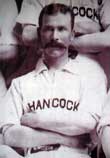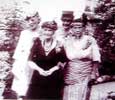Beaverton Edison Projecting Kinetoscope '97
 ROBERT GUTTERIDGE, shown here pointing at the Beaverton Kinetoscope, did the initial research for an article in our Journal. His December 2000 slide show amplified that article with a detailed history of the White family and how their Kinetoscope survived, plus a comparison of the projector with a similar model owned by George Eastman House in Rochester.
ROBERT GUTTERIDGE, shown here pointing at the Beaverton Kinetoscope, did the initial research for an article in our Journal. His December 2000 slide show amplified that article with a detailed history of the White family and how their Kinetoscope survived, plus a comparison of the projector with a similar model owned by George Eastman House in Rochester.
 Members of the White family migrated to Hancock, Michigan in the 1880s when demand for copper from the area grew with the rollout of electrical distribution networks and telephone lines in the age of electricity.
Members of the White family migrated to Hancock, Michigan in the 1880s when demand for copper from the area grew with the rollout of electrical distribution networks and telephone lines in the age of electricity.
 Bill White became the manager of Stringer's Grocery store. His sister opened a number of Millinery shops in the area. In the Late 1890s Bill purchased an 1897 Projecting Kinetoscope manufactured by Edison. He travelled around showing the short film loops created by Edison for his machine.
Bill White became the manager of Stringer's Grocery store. His sister opened a number of Millinery shops in the area. In the Late 1890s Bill purchased an 1897 Projecting Kinetoscope manufactured by Edison. He travelled around showing the short film loops created by Edison for his machine.
He moved back home to Beaverton, Ontario and showed movies thought to be the first in Canada.
thought to be the first in Canada.  In addition to private shows in homes, early shows were presented in halls such as this second story facility still standing today in Beaverton.
In addition to private shows in homes, early shows were presented in halls such as this second story facility still standing today in Beaverton.
The projector was cranked by hand. Illumination was provided by an arc lamp assembly. Shown here is the  arc light cabinet with the door open so the two arc rods are visible. The handles behind the cabinet were used to adjust the arc to make it ignite and then to maintain the light as the rods burned down and the gap increased.
arc light cabinet with the door open so the two arc rods are visible. The handles behind the cabinet were used to adjust the arc to make it ignite and then to maintain the light as the rods burned down and the gap increased.
If electricity was unavailable, lime light was created on the spot with portable chemical containers and gas light apparatus shown here. The lime light was an intense white light.
 The film was usually in the form of a fifty foot or shorter endless loop. Edison made the loops in versions for his "peep show" style Kinetoscopes (dense images) and his "projecting" Kinetoscopes (much lighter images).
The film was usually in the form of a fifty foot or shorter endless loop. Edison made the loops in versions for his "peep show" style Kinetoscopes (dense images) and his "projecting" Kinetoscopes (much lighter images).
The projector consisted of three discrete components. A Spool Bank to hold up to 50 feet of film, A light source, and  the projector with it's lens, gate and crank mechanism. The projector could be converted from Spool Bank to the use of crude eight spoke reels. Some owners cut a hole in the bottom of the projector housing and let the film drop into a cloth bag as it was projected, eliminating the nuisance of rewinding from reel to reel.
the projector with it's lens, gate and crank mechanism. The projector could be converted from Spool Bank to the use of crude eight spoke reels. Some owners cut a hole in the bottom of the projector housing and let the film drop into a cloth bag as it was projected, eliminating the nuisance of rewinding from reel to reel.
 Robert showed us catalogues which suggested the 1897 model was a "new and improved" version of the projector, implying an earlier model existed too. He speculated that Edison may have pressed on with the design of the projector, but held back on marketing and manufacture until litigation issues with Vitascope (which he was undercutting with his new projector) were resolved.
Robert showed us catalogues which suggested the 1897 model was a "new and improved" version of the projector, implying an earlier model existed too. He speculated that Edison may have pressed on with the design of the projector, but held back on marketing and manufacture until litigation issues with Vitascope (which he was undercutting with his new projector) were resolved.
The Beaverton projector survived because one of the White girls kept the instrument in her home after it's useful days were over. Sixty years later, the projector was casually offered to the owner of the Strand Theatre in town where today it is proudly displayed in the Lobby along with left over tickets and film loops.
In the follow up to his article, Robert visited George Eastman House (GEH) in Rochester and compared the Beaverton projector with the one owned by GEH. The Beaverton example is missing the lens and nameplate and varies slightly in the construction of the gate. The GEH example is missing a handle, and someone cut a crude hole in the base to let film fall through to a "take up bag". Go to beaverton.html for more pictures.
The images on this page were recorded from projected slides with a Nikon Coolpix 990 camera (any fuzziness is due to my shaky shots). The images were subsequently adjusted for size, colour balance and light values using Photoshop.
Bob Carter



